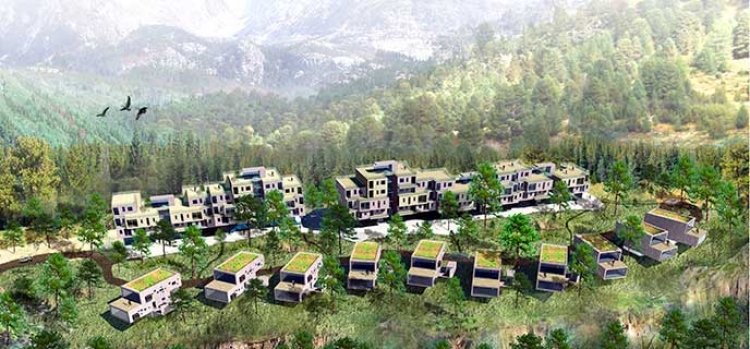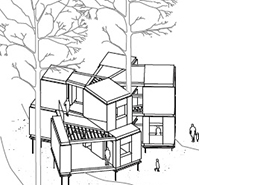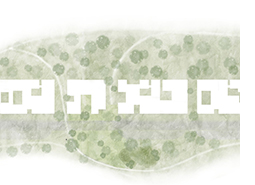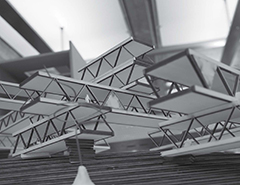
Urban housing in wood - Possibilities for prefabrication
SPRING 2014
Course description:
The studio will investigate two typical areas for densification in Oslo, one at the perimeter of the city, and one along the main road net. The objective is to develop project proposals with high density and architectural quality, and to develop well studied building systems with wood as the main material.
There is a considerable pressure to increase prefabrication of buildings, especially in the housing sector. We have seen various systems come and go, with varying degree of success. In Norway, the company Moelven byggmodul is a well known producer of building modules that can be stacked vertically and horizontally. These are much used, yet this is a system of limited architectural adaptability. and may be challenging to adapt locally. In Sweden, the contractor NCC established a factory for flat-packed housing, but had to shut down after only a short period, due to failing economy. Similar problems have terminated several other initiatives. One problem seems to be that these systems lack the required flexibility, making adaptations to complex sites difficult, and thereby generating extra expenditure which exceeds the savings to be made in a more rational and industrialized production.
If we wish to use prefabricated wood-based building systems for housing densification in and around our city centers, these systems must be designed for effortless adaptation to local topography and existing built environment. Additionally, they should allow for a rich and varied architecture. The studio poses the following question: Could a system based on prefabrication of smaller elements, such as load bearing frames, doors, windows, etc., be more robust and adaptable than a system based on larger modules with fixed measures?
Throughout history we find several examples of prefabricated systems where joints and structural connections are predetermined, while lengths and dimension may vary. The traditional Japanese house is one example of such a system, the Norwegian log house is another. Is there a lesson for modern, industrialized housing production to be learned from such examples? During an introductory phase, the studio will study various examples of more or less prefabricated building system in wood. We will also introduce producers of systems and components, in Norway as well as in other countries such as Austria and Japan.
Tutors: Børre Skodvin, Ute Groba, Lars Hamran
Students: Stig Andre Clason, Enya Regine Aamo Aspen, Magnus Flo, Enok Gåsland, Glenn Alexander Bjørnsson, Liv Kristi Hanstad, Adrian Rove Nordgård, Rikke Christine Nyrud, Mira Aanes Wolden, Ragnhild Kristin Liaset, Merete Claudi-Tønnessen, Ketil Andersen, Børge Goa, Simon Natanael Korsmoe, Rita Moholt
External examiner: Reinhardt Kropf, Helen and Hard
 RESIDENCE IN THREE-D - by Enok Gåsland
RESIDENCE IN THREE-D - by Enok GåslandThe project offers a more articulated, three-dimensional approach to residential architecture. The project combines prefabricated rooms partly enclosed and partly connected by a triangulated timber skeleton that inspires new thinking about the spatial organisation of residential functions. The project explores the architectural potential of resident-adapted mass-production housing based on CNC technology.
DOWNLOAD PROJECT DESCRIPTION HERE (pdf)
 LIFE BETWEEN THE TREES - by Rikke Nyrud and Enya Aamo Aspen
LIFE BETWEEN THE TREES - by Rikke Nyrud and Enya Aamo AspenThe project aims to build a residential project in and around an existing pine forest in the outskirts of Oslo. The project proposes a series of prefabricated volumes that are lifted off the ground and placed in-between existing trees on site. Focus is on area efficiency and adaptability to to the topography and the vegetation on site. Open and generous spaces are generated between the building volumes.
DOWNLOAD PROJECT DESCRIPTION HERE (pdf)
 HERE, BUT NO FURTHER - by Mira Wolden and Liv K. Hanstad
HERE, BUT NO FURTHER - by Mira Wolden and Liv K. HanstadThe project proposes a thin band of residences at the border between the city and the surrounding "marka" nature reserve. The project is built with prefabricated CLT walls and slabs. The cladding is charred spruce panels.
DOWNLOAD PROJECT DESCRIPTION HERE (pdf)
 OVER - by Stig Andre Clason and Glenn Alexander Hansen
OVER - by Stig Andre Clason and Glenn Alexander HansenThe project is based on a large L shaped building module that can be positioned in different ways to create a variety of spaces and residences. The whole project is lifted from the ground and supported by and enclosed in a system of timber trusses. The trusses allow for long free spans and flexibility inopen and closed spaces.
DOWNLOAD PROJECT DESCRIPTION HERE (pdf)
To order high resolution of project descriptions:
The above project descriptions have been reduced in size for ease of upload and accessibility. This may in some cases have affected the overall quality and resolution of images or drawings. You can request high resolution copies of the original documents by contacting the WBB using the email wbb@aho.no. Please stipulate the title of desired project and intended purpose and/or use of project material.